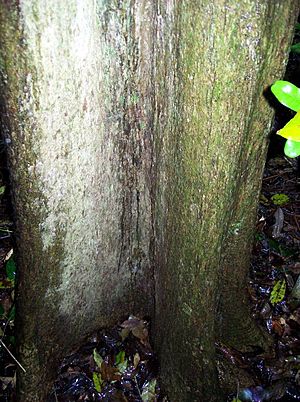Ehretia acuminata facts for kids
Quick facts for kids Ehretia acuminata |
|
|---|---|
 |
|
| A Koda tree trunk in Booyong, Australia | |
| Scientific classification | |
| Genus: |
Ehretia
|
| Species: |
acuminata
|
| Synonyms | |
|
Ehretia serrata Roxb. |
|
The Ehretia acuminata, often called the Koda tree in Australia, is a fascinating tree that loses its leaves every year (this is called being deciduous). It grows in many parts of the world, including Japan, China, Bhutan, Nepal, Laos, Vietnam, New Guinea, and Australia. Scientists believe this type of tree has a very old history, going back to a time when many of the world's continents were still joined together.
In Australia, the Koda tree is very common. You can find it from near Bega in southern New South Wales all the way up to Cape York in far northern Australia. Koda trees usually grow in different kinds of rainforests, especially around the edges or in areas that have been disturbed.
Contents
What Does the Koda Tree Look Like?
The Ehretia acuminata is a medium to large tree. It can sometimes grow as tall as 30 meters (about 98 feet) and its trunk can be as wide as 90 centimeters (about 3 feet) across!
The bark of the Koda tree is a creamy grey color and has vertical cracks or grooves. It's often easy to spot a Koda tree in winter because it loses its leaves. Also, the bottom of its trunk often has special grooves or ridges, almost like columns, which helps identify it.
Leaves, Flowers, and Fruit
The leaves of the Koda tree grow one after another along the branch. They are simple in shape, tapering to a point, and have small teeth along their edges. Each leaf is usually 8 to 13 centimeters (about 3 to 5 inches) long. They are smooth and green on both sides, though they might be slightly hairy on top. The main vein and side veins are easy to see on both sides of the leaf, and they stick out on the underside.
The flowers are white and smell sweet. They grow in clusters called panicles. Each individual flower is small, about 4 millimeters (less than half an inch) across, and doesn't have a stalk. In the southern hemisphere, these flowers usually appear from September to November.
The fruit of the Koda tree ripens in Australia from January to April. In China, it ripens in September. The fruit is a yellow or orange drupe, which means it's a fleshy fruit with a hard pit inside (like a cherry or peach). It's about 4 to 5 millimeters (less than a quarter inch) wide and contains four seeds. People can eat the fruit, and it tastes sweet. Many rainforest birds love to eat these fruits, including the Lewin's honeyeater, rose-crowned fruit-dove, brown cuckoo dove, wompoo fruit dove, and Australasian figbird.
If you want to grow a Koda tree from seed, it's quite easy! Just make sure to remove the fleshy part of the fruit from around the seeds. The seeds usually sprout quickly.
How is the Koda Tree Used?
The Koda tree is used in several ways. It's often planted along roadsides to make areas look nice. Its wood is also used for building things and making furniture. In some places, like China, parts of the Koda tree are used in Traditional Chinese medicine.
Images for kids
See also
 In Spanish: Ehretia acuminata para niños
In Spanish: Ehretia acuminata para niños






